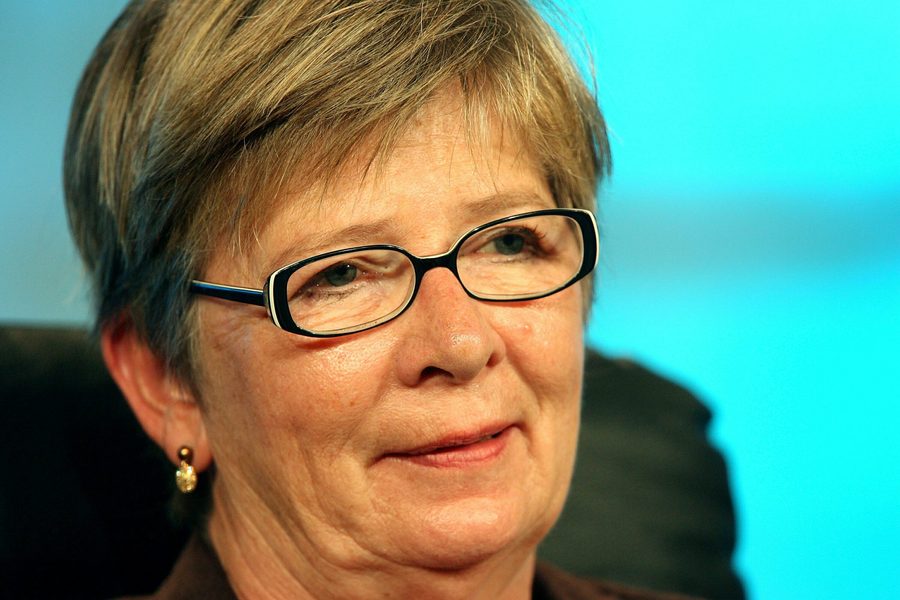Barbara Ehrenreich’s Call for Socialist Feminism
“Feminism—despite all our efforts—is still largely a middle-class movement and ideology,” Ehrenreich wrote in 1984—words that are still relevant today.
Barbara Ehrenreich

Barbara Ehrenreich, that giant of American feminism and leftist thought, passed away September 1. She leaves us with a canon of work that sheds an unrelenting light on the way social class shapes American life. Writing for In These Times in 1984, Ehrenreich argued that, while American women voters were moving to the left of men, it might not be because of feminism — it was because of the attacks on the welfare state. As female voters increasingly joined the working class, Ehrenreich offered, liberal feminism would never be enough; only a socialist-feminism could accommodate and respond to this shift.
In 1984, Barbara Ehrenreich wrote the following — which is still relevant today:
The potential strength and the current weakness of American feminism seemed encapsulated in an event I attended last February in New Hampshire. The occasion was a Susan B. Anthony award dinner hosted by the YWCA, which has become, as it has in many regions, something of a feminist front group in the state. Five hundred women filled the ballroom of a fading, roadside motel, up from 350 last year.
They were young and old (many, in fact, mother-daughter pairs); some dressed in the professional woman’s standard suit-and-silk-blouse, others in their cocktail party best, and a sprinkling in country-feminist blue jeans and sweaters. There were rousing anti-Reagan speeches, moving personal testimonials, standing ovations, songs and much embracing and moist-eyed appreciation all around. It was down-home American feminism at its best — a movement that has succeeded in developing a broad oppositional culture without getting side-tracked into a subculture.
Afterwards, a few of us looked in at a Walter Mondale rally that had been tacked on, somewhat opportunistically, to the main event. The draw here was three nationally known feminists: a vice president of NOW, which had recently endorsed Mondale; New York City Council President Carol Bellamy; and Betty Friedan. They spoke briefly, hammering away on the theme of Mondale’s electability — but they could not fully distract all of the 75 assembled women from the cash bar on one side of the room. It was a lackluster event in which everyone seemed to accept the premise that the women’s movement was now captive to the Democratic Party’s center and its front-running candidate — a curiously resigned attitude, given that women’s political power has never been greater.
For the first time since American women achieved suffrage in 1920, women are a recognized political force — feared by Republicans and courted assiduously by Democrats. Political commentators from Kevin Phillips to Bella Abzug agree that women could decide the presidential election of 1984, and that their decision will go resoundingly against Ronald Reagan.
The key to their new power is the gender gap. In 1980, and again in the congressional elections of 1982, women’s vote diverged from men’s by approximately 10 percentage points in favor of the Democrats. Opinion polls showed a parallel divergence in political attitudes: women are more pacifist than men, more concerned about the environment, and more supportive of government social welfare programs. Now peace, social welfare and environment are described as the “gender gap issues.” Disconcertingly, neither the Equal Rights Amendment nor abortion make that list. To judge from poll data alone, American women have not on the whole become more feminist than men; they have moved to the left of men.
An American exception
This development is not only historically unique for the U.S. It is unique internationally. In the United Kingdom and Europe, there has traditionally been what we could label a “reverse gender gap”— women have voted more conservatively than men, especially where there is a Christian Democratic Party to vote for. In Europe women have become more liberal in recent years, so that the “reverse gender gap” is closing. But nowhere except in the U.S., as far as I can discover, have women actually moved to the left of men. Here we seem to have a genuine case of American exceptionalism; and if no one has so far noted this in the volumes of commentary on the gender gap, it is because of our equally exceptional provincialism.
Explanations for the gender gap usually contain the following ingredients, in varying proportions: “feminine values,” such as nurturance and compassion, which are believed to predispose women to a peaceable and welfare-statish political stance; the rapid influx of women into the workforce, especially in the ’70s; the rise in the number of women who are single heads of households; Ronald Reagan; and feminism itself. Obviously, feminine values do not explain much by themselves, since they should have been just as strong in 1960 as in 1980 and should be as compelling in Italy as in the U.S. So the usual line of reasoning is that feminine values have somehow been activated or de-repressed as women have gained a measure of independence from men.
The transition from the supermarket to the labor market has, unquestionably, been an eye-opening one. Most working women are concentrated in stereotypically female occupations that do not pay enough to support a family or even a fairly ascetic individual. Meanwhile, more than nine million American women are the sole support of their families (up by 100 percent since 1970), and under conditions that have been made all the more difficult by Reaganomics. The American welfare state, which was always shamefully inadequate by European standards, has been savaged by cutbacks. The capital offensive against labor in the workplace is in full swing — and these are surely radicalizing conditions for anyone who must go home at night to feed her children. To emphasize these developments’ importance, polls find the most “liberal” women, statistically speaking, are unmarried, employed and/or black or Hispanic.
How much feminism itself has had to do with the creation of the gender gap is hard to say. Naturally, we would like to take credit for it, and the threat of the gender gap has been used by feminists to bludgeon Congress into voting for child support enforcement legislation and a modicum of public sector job creation for women, among other worthy things. Similarly, it is the gender gap, rather than any innate chivalry or conscience, that has impelled the Democratic presidential candidates to state their willingness to consider female running mates and to promise undying support for the ERA.
But if feminists invoke the gender gap to achieve feminist aims, they cannot easily claim that the gap represents the emergence of an explicitly feminist mass constituency. The timing is right — the gender gap follows on the feminist revival of the ’60s and ’70s (whereas the winning of the vote in 1920 coincided with the death of the earlier feminist movement). But the issues — peace and social spending rather than the ERA — are not.
My own interpretation is that the aggregate gender gap has more to do with the proletarianization of women under the current adverse conditions than it does with feminist ideology. It is poor women, and most strikingly, poor, single, working women, who account for much of the aggregate gap, and feminism — despite all our efforts — is still largely a middle-class movement and ideology. But if feminism cannot take credit for the aggregate gap, it probably can take credit for the “elite gap” — the difference between college educated, and presumably middle-class, men and women. In the 1980 election the “elite gap” was greater than the gap at any other socio-economic level: 17 percentage points, or more than twice the national average (i.e., 58 percent of male college graduates chose Reagan, compared to 41 percent of comparable women voters).
Of course, economic determinism could be at work even among the “elite”: college-graduate women are much less likely than men to actually be middle class, especially on the strength of their own earnings. But I would not discount the effect of feminism as a liberal, or socialdemocratic, ideology, and here again an element of American exceptionalism comes into play. In the absence of labor party or significant socialist political presence, the women’s movement fees been a major carrier of social democratic values throughout the ’70s and ’80s. For example, at one of the most important feminist events of the ’70s — the federally-sponsored First National Women’s Conference in Houston in 1977 — women voted for a program of reforms that, with the deletion of gender references, could have been taken for the platform of a European socialist party. The program was entirely ignored by President Carter, but the “spirit of Houston” is, if anything, stronger than ever. American feminism may be “bourgeois,” “individualistic” and all the other things its left-wing detractors have said about it, but it is also a powerful force on the left — and all the more so since the arrival of Reagan and his New Right, anti-feminist shock troops.
Class treason
If I am right about the role of feminism in creating the “elite gap,” one could say that feminism has acted to alienate relatively privileged women from their own class interest: from the pro-business, proCold War interests of the men of their class. Of course this is not universal; many young women have been inspired by feminism to elbow their way into Wall Street law firms and high-paying medical fields, and it is not clear whether feminist, or even “feminine” values can survive in these settings. But the new tendency of women to identify themselves as Democrats is striking, as is the growing disaffection of many high-placed Republican women. For example, National Women’s Political Caucus President Kathy Wilson, who is in the increasingly oxymoronic position of being a Republican feminist, has called the president a “danger,” and former Reagan functionary Barbara Honegger has been campaigning as a feminist for Jesse Jackson. These are laudable cases of class treason, inspired not only by the male belligerence of the president, but by the strength of feminism as an inter-class ideology that potentially links even upper-class women with the most oppressed of their sisters.
If the “elite gap” is a measure of the present constituency for feminism, then it seems to me that the aggregate gap is a measure of the possible constituency for feminism. Women are voting differently from men in no small part because they are less likely to be tied to men by financial dependency. They do not experience the “privilege,” so often invoked by Phyllis Schlafly, of being full-time housewives. They face male authority, and blatant sexism, in its public forms — at work and in the crumbling institutions of the welfare state. Surely these are the “material conditions” for at least a proto-feminist, as well as a proto-socialist, kind of consciousness.
But who is going to articulate this consciousness and help it find a more forceful expression than that offered by the current leadership of the Democratic Party? Probably not the women’s movement’s mainstream national leadership, not only because their approach to politics has become increasingly “professional” and detached from grassroots mobilization, but also because their premiere issues — the ERA and a woman vice president — are, for many women, somewhat remote and symbolic.
The best hope, it seems to me, is for the re-emergence of socialist-feminism, not as an organizationally separate tendency, but as a political spirit infusing— and bringing together — the women’s movement and the various pieces of the left. Liberal feminism, to use Juliet Mitchell’s old categories, has been the defining core of American feminism. It gave feminism legitimacy in a country that lacks a sturdy radical tradition, and it has been able to involve and unite women across class and party lines. But it can no longer keep up with its own constituency, potential and actual. When women move to the left, so must feminism
Barbara Ehrenreich was a journalist and author who first wrote for In These Times in 1977. Her books include Bright-sided: How Positive Thinking is Undermining America, Nickel and Dimed: On (Not) Getting by in America, and Blood Rites: Origins and History of the Passions of War. She was a regular contributor to The Progressive, Harpers, Time and In These Times, where she was a contributing editor until her passing in September 2022.









